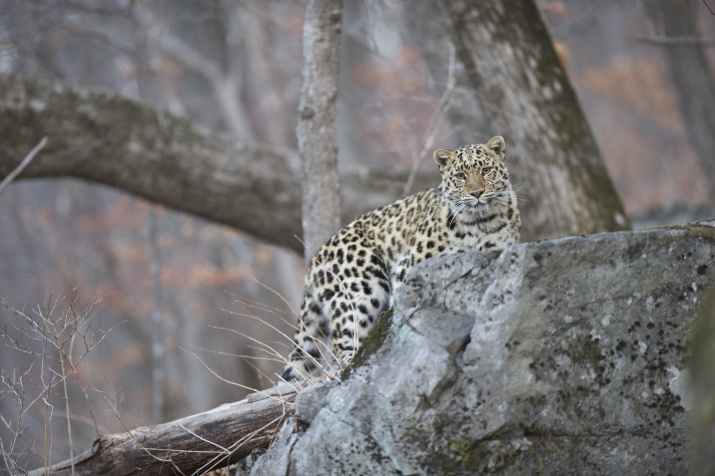A new route will be opened in the Land of the Leopard
Protection of endangered species: Amur leopard
Since 2011, the Russian Geographical Society has been actively involved in projects to restore the Amur leopard population. Our goal is to study the state of the populations of the predator and its main prey – ungulates; as well as the development of the infrastructure of protected areas within its range.
The Amur leopard is the rarest subspecies of the Felidae family on Earth. Due to active hunting and the reduction of habitable territory, by the end of the 20th century the species was on the verge of extinction: in the Far East, only about 35 specimens remained.
In 1998, the Russian government approved the "Strategy for the Conservation of the Amur Leopard in Russia." In November 2013, the Ministry of Natural Resources and Environment of the Russian Federation approved a new version of the Strategy developed by WWF experts and the scientists of the Far Eastern Branch of the Russian Academy of Sciences.
Efforts yield results: according to photo monitoring in 2018, in Russia - in the “Land of the Leopard” National Park - there were 91 adult animals and 22 kittens. A small number of predators also live in China and North Korea. The species is still under threat; for its stable existence, at least 150 specimens are needed.
Since 2011, the Russian Geographical Society and its partners have done the following to study and preserve the Amur leopard:
- In 2011, the autonomous non-profit organization “Far Eastern Leopards” was founded, whose activities are supported by the Russian Geographical Society. The main task of the ANO is the accumulation of sponsor funds, their effective use to save the population of these graceful and rare cats.
- In 2011, A. N. Severtsov Institute of Ecology and Evolution of the Russian Academy of Sciences received a grant from the Russian Geographical Society for the implementation of the Program for the Study of Rare and Endangered Animals. As part of the implementation of the grant, the Center for the Reintroduction of the Amur Leopard was created at the Ussuriysky Nature Reserve of the Far Eastern Branch of the Russian Academy of Sciences.
- Grants of the Russian Geographical Society for the implementation of the Program for the Study of Rare and Endangered Species were also issued in 2015, 2016, 2018 and 2019. Thanks to this, the specialists of A. N. Severtsov Institute of Ecology and Evolution of the Russian Academy of Sciences:
- carry out regular monitoring of the number of predators;
- by tracking method they find out the routes of movement, places of overnight rest, and marks;
- study the health status of leopards, their resistance to various viruses;
- analyze the level of genetic variation in the population and much more.
- In 2011, the Prince Albert II of Monaco Foundation, a member of the Board of Trustees of the Russian Geographical Society, became a WWF partner in the Siberian tiger conservation projects in Russia and China. This activity helps the conservation of the Amur leopard as well. The funds are allocated to support anti-poaching activities, the work of regional protected areas, tracking and preventing conflicts between local residents and large predators. In particular, with these funds, it was possible to strengthen the protection of the territory in the south-west of Primorye, where, in addition to tigers, the Amur leopard also lives.
- In 2012, with the support of the Russian Geographical Society, a new national park "Land of the Leopard" was created with an area of 282 thousand hectares.
- In the same year, the Russian Geographical Society issued a grant to “Far Eastern Leopards” Autonomous Non-Commercial Organization. With these funds were purchased transport, tracking devices and alarms. As a result, autonomous barriers appeared on the territory of “Land of the Leopard” with modern means of guarding the perimeter of the national park and signaling unauthorized entry.
- In 2015, with the help of a grant from the Russian Geographical Society, a photo monitoring system for large cats was set up. In particular, 200 out of 400 camera traps on the territory of the "Land of the Leopard" are installed at the expense of the Russian Geographical Society. Other participants in the project were the Sikhote-Alin and “Bastak” Nature Reserves, the ANO “Amur Tiger Center”, the ANO “Far Eastern Leopards” and A.N Severtsov Institute of Ecology and Evolution of the Russian Academy of Sciences.
- In 2016, as part of a program to conserve the population of the Amur leopard, the government initiated the construction of the Narva wildlife crossing over the highway on the territory of the “Land of the Leopard” National Park and the “Kedrovaya Pad” Nature Reserve. The federal highway went into the tunnel, and the pass was closed for transport, so that animals could use the trails without the threat of getting hit by a car.
- In 2019, with grant support from the Russian Geographical Society, the territory of the “Land of the Leopard” National Park was expanded to 6000 hectares due to the creation of a new cluster on the Gamova Peninsula (Khasansky District of Primorsky Territory). The work was carried out by the ANO "Far Eastern Leopards".
- In 2019, the “Land of the Leopard” National Park and the Northeast Tiger and Leopard National Park in China entered into a memorandum on working together to preserve the rarest cats. And in 2020, the joint project of these two national parks “Ensuring cross-border cooperation between neighboring protected areas for the conservation of the Amur leopard and the Siberian tiger” was included in the large project of the UN Commission for 2020–2023.
News
84 adult animals were recorded in the park in 2017
The camera of the Land of the Leopard national park caught an amazing hoofed animal
Such large scale tiger studies are held every 10 years
More than 1000 nicknames for the rarest cat in the world were suggested






